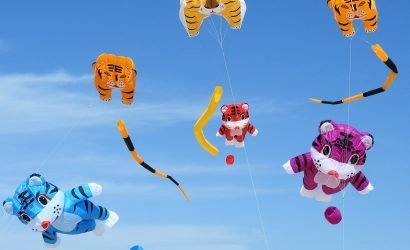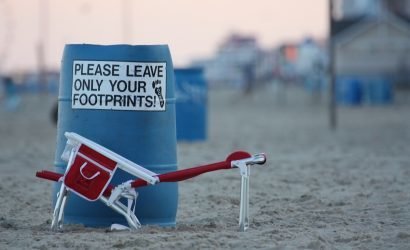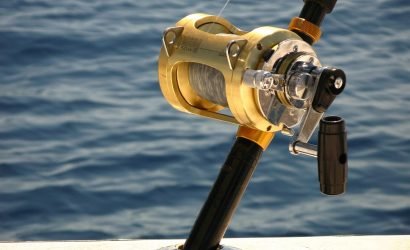In honor of ShoreBread’s Eco-Friendly April – all in preparation for Earth Day – we went on a little journey. A trip of sorts that most people would consider to be less than exotic even though the local waters are a crystal clear shade of teal, and rare birds circle the hills looking anxiously for a snack that’s been carelessly tossed aside by a visitor. Traffic may get backed up occasionally, but the drivers know how to handle the always shifting terrain.
 |
This is our recycling area; a bin for plastics, cans, lots of cardboard boxes, and a bag full of random paper products. Our regular trash is disposed of in a big dumpster that is emptied by Waste Management on a weekly basis. We choose to set aside all of our recyclables so they can be properly disposed of. In the Ocean City area, regular household garbage is collected once or twice a week while recyclables are picked up at least once every two weeks. Home trash and recycling programs can be paid on a monthly basis and are very convenient. |
 |
When the recycling pile becomes rather gigantic, we load all of our recyclable items into the trunk of a car and travel to a local recycling hub. There are recycling containers located all over the Eastern Shore. Several areas have designated recycling drop of centers. This trunk-load of trash was taken to the Berlin Transfer & Recycling Station. |
 |
The Berlin Transfer Station is located on Mill Haven Road in Berlin, MD. In 1992, the Town of Berlin engaged in a mandatory recycling program to benefit local economic and environmental resources as well as conservation efforts. The Transfer Station offers a place for Berlin residents to discard of their recyclable materials easily and safely. |
 |
There are several large green recycling dumpsters at the Transfer Station that are used for sorting materials. The following items are recyclable: glass bottles and jars, plastic, aluminum cans, foil, or food containers, ferrous, tin, bi-metal, newspapers, magazines, office paper, and corrugated cardboard. Our items were sorted and placed into their corresponding dumpsters. |
.JPG) |
Some items must be prepared before being placed in a recycling bin:
|
 |
When these big, green bins start getting full, they are picked up by a large truck. The dumpsters are replaced immediately so there isn't a pause in recycling capabilities. |
 |
The big green bins make their way along Route 113 towards Snow Hill. Many big trucks filled with trash travel this road several times day. The trucks pick up all refuse brought in that day from across the county. |
 |
The trucks carrying loads of trash and recyclables turn onto Holly Lane – just outside of Snow Hill, MD. Past the country Fire Training Center, over the worn railroad tracks, and through the woods lies the county's Central Landfill. |
 |
Man-made ponds filled with teal waters are surrounded by several hills. Raised land is not something we see on the shore often – if ever. These hills are large mounds of compacted trash. Welcome to the Worcester County Landfill. County residents can purchase a permit sticker if they wish to use the County Landfill. The stickers vary in price based up usage levels. A sticker allows citizens to bring their trash and bulk items to the transfer station for disposal. Transfer station employees hold the responsibility of seeing that all items are properly disposed of. |
 |
The landfill is quite a site to see. It is a serene and mystical place to visit. The bright waters are home to many varieties of birds- including a nest of young bald eagles. Truthfully, if you didn't know that it was a dump, you might think it were a nature conservancy. |
|
|
The birds feast on discarded trash. They pick at edible items after the trash trucks dispose of their loads in the landfill. Some birds quickly fly back to their nest with remnants of someone's dinner from the night before that had been discarded of in their household trash. |
 |
The trucks that enter the landfill, filled with trash, drive to the top of the open hill and unload their contents. The trucks filled with recyclables head somewhere else – the recycle sorting station. |
 |
Large nets surround the newest landfill to keep loose items inside the space. The landfill is compacted, covered in loose soil, seeded with grass, the nets are removed, ground vents are installed, and the structure appears as though it is a big grassy hill. There are several buried mounds of trash on the Central Landfill property and room for more mounds to be created. |
 |
Not all trash is buried. Some is separated. These are all metals; bike frames, old machinery, barrels, and bed frames, for example. Many of these items come from home construction projects or home removal/discard efforts. These metals will be taken to another site and will be recycled or reused in some way or another. |
 |
Just down the dirt path that takes you from the landfill and the metal pile, you'll find the recycling center. |
 |
All of those recyclable products mentioned above are sorted and then squashed at the facility. Corrugated cardboard, plastics, and tin are compressed into four-foot squares and secured. Glass products are handled separately. Recyclables are just collected at the recycling center next to the landfill. The recyclable items are sorted, cleaned and bundled. These reusable items are considered a commodity – items that can be sold. The boxes, cans, bottles, and paper products you recycle can be broken down into raw materials and sold to manufacturers. Recycling programs will always remain feasible as long as consumers like products made from recycled materials. |
 |
Corrugated cardboard is turned into a pulp mixture when mixed with water. The broken down cardboard is mixed with wood shavings that provide strength and durability. Cardboard pulp can be combined with paper pulp. This combination is used to create things like paper towels and toilet paper. Shredded cardboard can be used to make cat litter. Pressed cardboard pulp is used to create fiber board, also known as particle board. |
 |
Each piece of plastic should have a number on it to identify it for recyclable sorting. Plastics are rated on a scale from 1 to 7. Plastics are made of different substances. This scale acts as a way for those recycling the material to know which plastics can be melted together and blended easily. Once sorted, the plastics get shredded by large machines. Those shredded pieces are then fed into another machine that heats and compresses the material, transforming it into pellets. These pellets are used to make fibrous carpet, floor tiles, outdoor lumber, thick bottles, and other durable products. |
 |
All recycled paper is turned into pulp. Much like cardboard, this pulp is created with water. The watered down paper pulp is set on wide screens that allow for drainage. Heated pressers apply pressure to the paper and smooth out the product. The sheets of pressed paper can then be cut into proper shapes and sent onward for packaging. |
Now that you’ve seen this little journey, how do you feel about recycling? We feel as though our recyclables are in good hands. They’ve been dropped off; they traveled; they’ve been cleaned, and now they are on another journey to a larger recycling center, off of the Eastern Shore, where they really can be turned into something new. Recyclables have a unique journey. Who knows when they could come back to you in a different form?
Do you take part in helping the environment? Always recycle and try to create as little trash as possible!
Check out these links below to read other eco-friendly ShoreBread stories:










